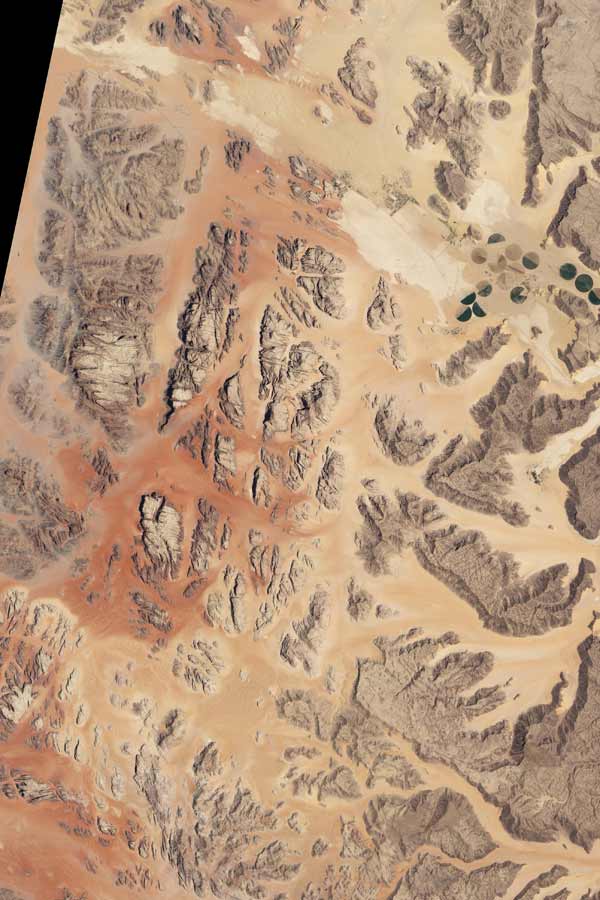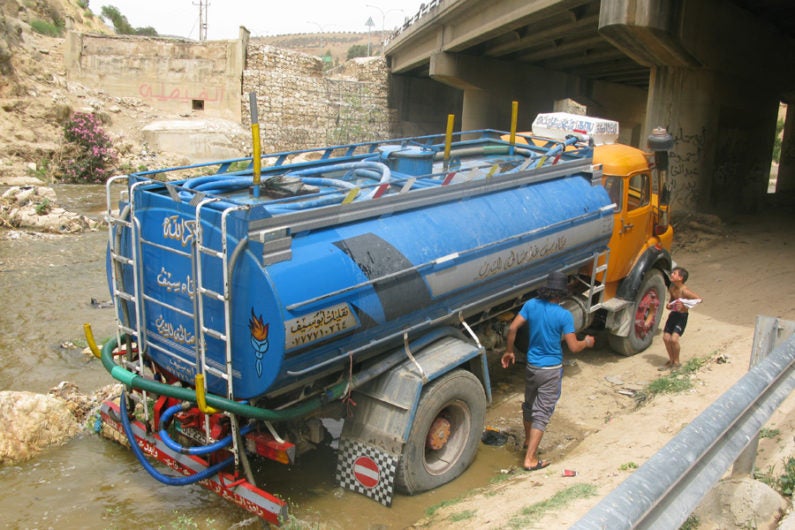Jordan faces likelihood of much more frequent long and severe droughts, Stanford researchers find
Jordan is among the world’s most water-poor nations, and a new, comprehensive analysis of regional drought and land-use changes in upstream Syria suggests the conditions could get significantly worse.
A new analysis of drought in Jordan – one of the world’s most water-poor countries – suggests that without alternate water sources, better land use and improved water-sharing agreements, the country could face a future of potentially disastrous droughts. The research, which was the first to analyze several types of drought and to take into account land use changes in upstream Syria, could inform water policies in other arid countries with shared rivers.

This satellite image shows the Wadi Rum desert and irrigated farmland in Jordan. (Image credit: NASA)
“Jordan’s ability to satisfy future urban and agricultural water demands will be stressed by cascading effects on its freshwater supply,” said study co-author Steven Gorelick, the Cyrus Fisher Tolman Professor in Stanford’s School of Earth, Energy & Environmental Sciences. “These impacts are from increasingly severe droughts and eventual agricultural land-use recovery in the aftermath of the Syrian civil war.”
Gorelick leads the Jordan Water Project, which is exploring water management and policy in Jordan with the hope of both improving water security in the water-poor nation and developing tools to improve water availability in other drought-prone regions. The recent paper, published August 30 in Science Advances, found that without significant changes, Jordan could face lower rainfall, much higher temperatures and as much as a 75 percent decline in water flowing into the country from Syria.
The situation would be exacerbated by increasing Syrian agricultural water use in the aftermath of the country’s prolonged civil war, which could further diminish flow to the Yarmouk River, the largest tributary to the Jordan River.
Management-focused analysis
Rather than focusing just on lower rainfall, the team measured three types of drought as they affect Jordan: rainfall decrease, agricultural soil moisture loss and declines in freshwater streams. They looked at each of those conditions through, first, a business-as-usual lens that assumes a lack of international climate-policy action with continued high rates of greenhouse gas emissions and, second, an optimistic scenario of reduced emissions with climate change policy interventions. They used the period 1981–2010 as a historical baseline against simulations for the years leading up to the end of the century.
The authors said this approach could better inform drought management by considering all vulnerabilities for people, agriculture and the environment. That’s because declines in streamflow and soil moisture, which are critical to freshwater supply and agriculture, are driven not only by lower rainfall but also by higher temperatures, evaporation and land-use change. Importantly, countries such as Jordan that are dependent on waterways flowing downstream to them are vulnerable to the consequences of drought and land-use change in upstream regions.
Sobering findings
The team’s results suggest that by the end of the century under a business-as-usual scenario, rainfall in Jordan will decrease by 30 percent, temperatures will increase by 6 degrees Celsius, and the number and duration of droughts will double. Increasingly severe drought events will occur almost every year. Flow from the Yarmouk River, an important source of water that flows from Syria, would decline by up to 75 percent.
“Most importantly, our findings also showed a steep rise in the simultaneous occurrence of multiple drought types,” said lead author Deepthi Rajsekhar, a former postdoctoral scholar in Gorelick’s lab now working at the California Department of Water Resources. “This brings on a compound effect and increases the overall drought impact significantly. The need for an integrated drought analysis has never been more important for water management.”
In a sad twist, an end to the Syrian civil war could add to Jordan’s water misery. That’s because resurgent Syrian agricultural operations now stalled by the conflict would draw heavily on the Yarmouk.
Toward solutions
Jordan’s experience holds lessons for not only countries in arid regions but also those that obtain supplies from one or more of the 278 trans-boundary waterways that feed into shared watersheds occupying nearly half of the world’s land.
Despite the challenges, countries such as Jordan have already gone a long way toward water security through sound water management such as efficient irrigation and extensive use of treated wastewater for agriculture. But regional cooperation on water is paramount. A shining example: Jordan, Israel and the Palestinian Authority signed an agreement to desalinate and share water from the Red Sea.
The Jordan Water Project is a program of the Stanford Woods Institute for the Environment’s Global Freshwater Initiative.
Gorelick is also a senior fellow at the Stanford Woods Institute for the Environment, director of the Global Freshwater Initiative at Stanford and director of the Hydrogeology and Water Resources Program at Stanford’s School of Earth, Energy & Environmental Sciences.
Funding was provided by the National Science Foundation and the Stanford Woods Institute for the Environment.

